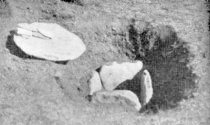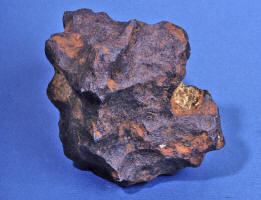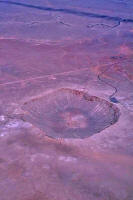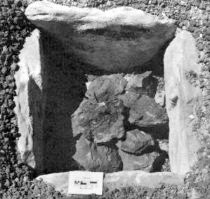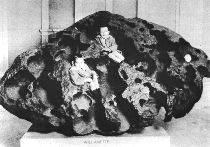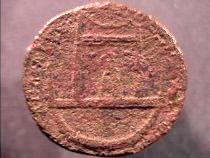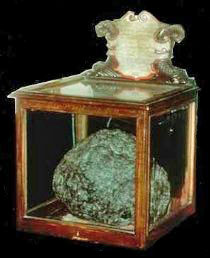|
from Meteorite Website
Throughout the ages, meteorites were venerated as sacred objects by different cultures and ancient civilizations.
The spectacular fall of a meteorite, accompanied by light and sound phenomena, such as falling stars, smoke, thunder, and sonic booms, has always kindled the human imagination, evoking fear and awe in everyone who witnesses such an event.
For obvious reasons, the remnants of these incidents, the actual meteorites, were often kept as sacred stones or objects of power.
They were worshiped, and used in their respective religious ceremonies.
The Winona Meteorite
Find Site
From Prehistoric
Times to Ancient Egypt
Archaeological finds throughout the United States and Mexico, proved that Canyon Diablo fragments had been traded briskly centuries before Columbus reached the shores of the New World.
The Winona meteorite was found in a stone cist in the prehistoric Elden pueblo, Arizona, in 1928.
The circumstances of the find suggest that the builders of the pueblo had kept the meteorite as a sacred object after actually witnessing its fall. The tribes of the Clackamas in Oregon claim that they once worshiped the Willamette meteorite, one of the largest irons known, weighing about 15 tons.
Prior to their hunting trips, the
Clackamas dipped the heads of their arrows and lances into the water
that had gathered in the large cavities of the iron - they were
convinced that this ritual would harden their weapons and grant them
success in their hunt.
Such knives and daggers have been recovered from the tombs of Egyptian Pharaohs, from Mesopotamian sanctuaries, and from the graves of the leaders of the Aztecs, Maya, and Inca, in both Americas.
Winona - A Sacred Meteorite?
The Willamette Iron Meteorite
Mircea Eliade, an expert in religious history, claims that the Palladion of Troy, the Artemis of Ephesos, as well as the Cone of Elagabalus in Emesa, were actually meteorites - stones that had fallen from the sky, objects from heaven, believed to contain supernatural powers.
Richard Norton mentions the sacred stone in the temple of Apollo at Delphi, a rock that was said to have been thrown to Earth by the Supreme Being, Kronos, marking the "omphalos", the navel of the world.
The Roman historian, Titus Livius, tells the
story of the meteorite of Pessinunt, Phrygia, a conical object known
as the Needle of Cybele, the goddess of fertility. After the Romans
had conquered Phrygia, the meteorite was conveyed in a gigantic
procession to Rome, where it was worshiped for another 500 years.
In the Hebrew language, meteorites were called "betyls", an equivalent to the Greek "baitylia", meaning "the residence of God". In the Bible, we find a story where Jacob, the ancestor of the Israelites, beds his head on such a betyl-stone in the desert. In his sleep, he has an impressive vision of a stairway to heaven leading directly to the throne of God.
The story says that Jacob was full of awe when he awoke, and that he built a temple around that stone.
However, nothing of this temple has been preserved up to this day.
Emperor Trajan
stone of Aphrodite in the temple of Paphos
There is another famous example from the Middle East, but there is some dispute about whether the object of veneration is actually a meteorite or not.
We are referring to the "Hadschar al Aswad", the sacred "black stone", to which all Moslems pay homage on their "Hadsch", their pilgrimage to Mecca and the most important sanctuary of the Islam, the Kaaba.
Each Moslem has the duty to make this pilgrimage once in his lifetime, to visit Mecca, and to walk around the Kaaba - a cubic building - seven times.
Then, he has to pause at the southeast corner of the Kaaba to complete the ritual, touching or kissing the Hadschar, also known as "Yamin Allah", meaning "the right hand of God".
Tradition says that this stone is a
betyl, a meteorite that was given to Abraham by the archangel
Gabriel. That stone also played a most important role in the life of
Mohammed, the prophet of Islam, who immured it into the wall at the
southeast corner of the Kaaba.
However, it might also represent a rather large Wabar pearl, a meteorite related impact glass that is found in central Saudi Arabia, not that far from Mecca. It's a pity that scientists haven't solved the mystery surrounding this sacred stone, but for normal religious reasons it has not been allowed.
Wouldn't it be great to know that there is at least one ancient betyl left, and that it is still venerated after more than perhaps 2,000 years?
The Famous Kaaba in
Mecca
The "Hadschar al Aswad"
From the Middle Ages
to Ensisheim
The guiding influence of Christianity condemned all pagan rituals and beliefs during the Middle Ages, leaving only traces of preceding religions and customs. However, even today meteors are regarded as omens in some rural regions in Germany, France, and Italy.
Some people believe that seeing a shooting star is a good omen.
They will literally wish upon a star, convinced that their wish will come true if they don't tell anyone what they have wished for. Others regard meteors as bad omens, and they make a cross, saying "Amen", "God guide it", or something similar to avert bad luck.
If we take into account the fact that these habits reflect older traditions, we can say with certainty that meteors and meteorites were poorly understood in the Middle Ages, and treated the same as other supernatural phenomena.
The Ensisheim Meteorite Fall Historic Fall of Ensisheim, 1492 The Thunderstone of Ensisheim
This ambiguity is well documented for one of the most famous European falls.
On November 7, 1492 - the
very year when Columbus discovered the New World - a huge triangular
stone landed with much noise in a wheat field outside the small town
of Ensisheim, Alsace, at that time still belonging to Germany and
the Holy Roman Empire.
Immediately, he had the unusual stone transported to his residence in an effort to protect it and his careless citizens.
The whole affair attracted much public attention, causing Emperor Maximilian to visit Ensisheim 15 days after the fall to hold court over the "Thunderstone of Ensisheim" and to determine the meaning of the occurrence. After some consideration, he decided to take the fall as a good omen in his ongoing wars with France and the Turks.
However, he ordered that the stone had to be preserved in the local church - fixed to the wall with iron chains to prevent it from either wandering around at night or departing in the same violent manner by which it had arrived.
Today, the main mass of this famous meteorite can still be seen in the Regency Palace of Ensisheim as the centerpiece of a most remarkable meteorite collection.
|

